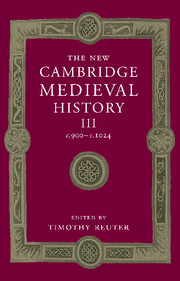Book contents
- Frontmatter
- 1 Introduction: reading the tenth century
- PART I GENERAL THEMES
- PART II POST-CAROLINGIAN EUROPE
- PART III NON-CAROLINGIAN EUROPE
- 19 European Russia, c. 500–c. 1050
- 20 Bohemia and Poland: two examples of successful western Slavonic state-formation
- 21 Hungary
- 22 Byzantium in equilibrium, 886–944
- 23 Bulgaria: the other Balkan ‘empire’
- 24 Byzantium expanding, 944–1025
- 25 Byzantium and the West
- 26 Southern Italy in the tenth century
- 27 Sicily and al-Andalus under Muslim rule
- 28 The Spanish kingdoms
- Appendix genealogical tables
- List of primary sources
- Bibliography of secondary works arranged by chapter
- Index
- Frontispiece
- Plate section
- Map 2: Archbishoprics and bishoprics in the early eleventh century
- Map 4: Germany
- Map 13: Byzantium in 1025
- References
24 - Byzantium expanding, 944–1025
from PART III - NON-CAROLINGIAN EUROPE
Published online by Cambridge University Press: 28 March 2008
- Frontmatter
- 1 Introduction: reading the tenth century
- PART I GENERAL THEMES
- PART II POST-CAROLINGIAN EUROPE
- PART III NON-CAROLINGIAN EUROPE
- 19 European Russia, c. 500–c. 1050
- 20 Bohemia and Poland: two examples of successful western Slavonic state-formation
- 21 Hungary
- 22 Byzantium in equilibrium, 886–944
- 23 Bulgaria: the other Balkan ‘empire’
- 24 Byzantium expanding, 944–1025
- 25 Byzantium and the West
- 26 Southern Italy in the tenth century
- 27 Sicily and al-Andalus under Muslim rule
- 28 The Spanish kingdoms
- Appendix genealogical tables
- List of primary sources
- Bibliography of secondary works arranged by chapter
- Index
- Frontispiece
- Plate section
- Map 2: Archbishoprics and bishoprics in the early eleventh century
- Map 4: Germany
- Map 13: Byzantium in 1025
- References
Summary
the reign of Constantine VII Porphyrogenitus as senior and dominant emperor (945–59) has long been viewed as the apogee of Byzantium as a great power resplendent in culture and learning. Constantine, like his father Leo, saw himself as a writer and instructor, and he was interested in many branches of written knowledge. This was partly a matter of theoretical knowledge or erudition about the past, but Constantine regarded the practical experience relayed by writings as indispensable to an emperor, as he stated in his preface to the De administrando imperio, a secret handbook devoted principally to foreign peoples and compiled for the instruction of his young son so that foreign nations ‘shall quake before thee as one mighty in wisdom’.
Constantine’s public stress on learning reflected his own views and there is no reason to doubt the characterisation by the author of a Synaxarium, a history of the saints celebrated through the church year, commissioned by the emperor. Constantine, rising before the birds, was zealous to study ‘every book’ and read through ‘the ancient … histories’ from which one could become ‘experienced … in all kinds of matters’. This, like the standard preface to the fifty-three instalments of extracts from classical and early Byzantine historical works commissioned by Constantine, asserts the special access of the emperor to wisdom through the books amassed in his palace. An emperor who exploited these reserves of past experience and piety was uniquely wise and reverend. But Constantine was simultaneously offering the ‘benefit’ of his digests ‘to the public’, in the words of the preface. This exaltation of book-learning was in the tradition of Constantine’s father, Leo ‘the Wise’; both were palace-dwellers, and both asserted that the books and learning accumulated behind its closed doors were, through their mediation, relevant and advantageous to their subjects.
Keywords
- Type
- Chapter
- Information
- The New Cambridge Medieval History , pp. 586 - 604Publisher: Cambridge University PressPrint publication year: 2000



